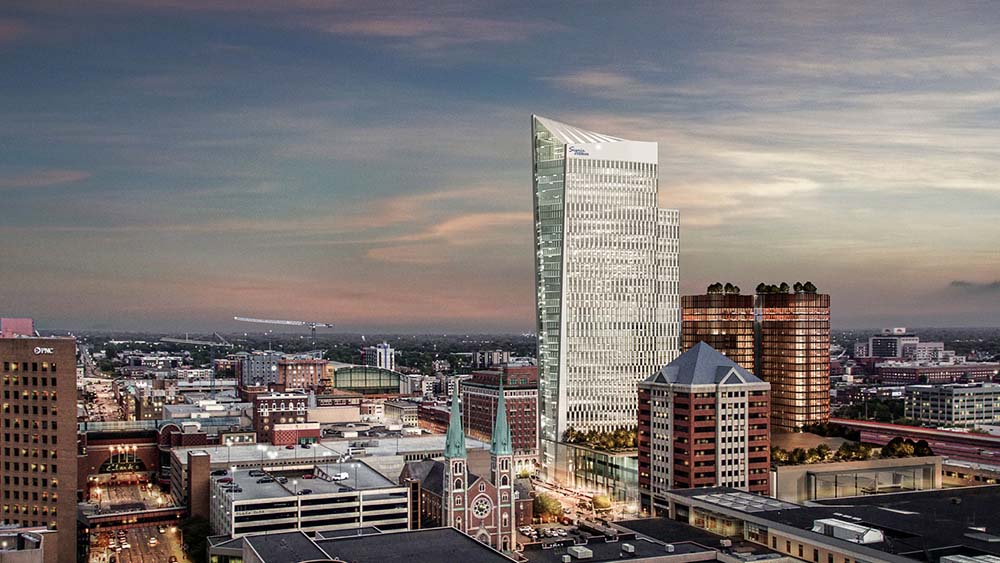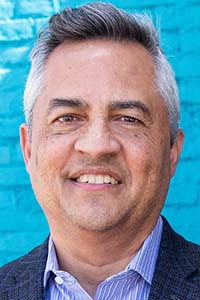
The Indianapolis City Council will take over financing a 40-story, approximately 800-room Signia by Hilton convention center hotel that has long been in the works. (Rendering courtesy of Hilton)
More than half of hotel projects in the U.S. in the pre-construction or groundbreaking phase this year are now on hold, according to a recent story in Bisnow Houston — the result of stricter lending standards making it more difficult to secure financing.
That article set the stage for an Indianapolis Star news story published the same day: The Indianapolis City-County Council announced it had approved the city taking over financing for a 40-story, approximately 800-room Signia by Hilton convention center hotel after Kite Realty Group Trust experienced challenges securing funding in the private market. The city will finance the $510 million cost of building the hotel and build up a reserve fund to allow the hotel to operate without revenue for up to a year and a half, if necessary — $625 million in hotel revenue bonds were approved to finance the project.
Convene spoke with Leonard Hoops, Visit Indy’s president & CEO, to learn more about this initiative and whether he thinks the current market will spark a similar public funding model in other destinations. Here’s what he had to say.

Leonard Hoops
Some History on this Project
Like a lot of DMOs, we have a customer advisory board. And that customer advisory board includes clients of ours who have big annuals here. They started sharing with us in 2014 at a customer advisory board event that they thought we would need to add another headquarter hotel sometime in the next decade. We had just opened a 1,013-room JW Marriott in 2011 and were in phase 5 of our convention center expansion in 2011, but their point was that [this kind of development] takes a decade, which I knew from my own work in the three cities I’ve been in before Indy. In late 2017, [the local administration] started working with us on the project and in early 2018, after we had done a study with a third party, we did an RFP. That RFP led to the Pan Am Plaza site and a Hilton product at the time.
The developer that owned that land was also the developer of the Conrad Hotel in Indy. The plan was for the deal to get done in 2019, and in 2020, the developer would go to the private banking market and get the funds necessary to get this off the ground. And the historically low interest rates and all the sorts of things that made this very doable for private development went away. Meanwhile, in the fall of 2020, in the middle of the pandemic, our city council went ahead and approved the convention center expansion part of this project, so that was great news for us.
[The decision was made to delay the hotel part of the project for two years] and to not break ground on this until late 2022, because we wanted to open in a forecasted upturn in the market. That was prior to the Federal interest rate hikes that we’ve since seen. And so, as a result of that intentional two-year delay on the hotel side, we now found ourselves in late ’22 with interest rates having been raised 10 times, and then you start getting this regional banking crisis.
The Funding Model Pivot
So that leads us to where we got to with this deal. A couple of months ago, the city leadership who had been working with the developer on this project came to me and said, “What do you think about the city owning this hotel?” And I said, “Well, I know that’s how the Dallas Omni was built. I know that’s how the Signia in Atlanta has been getting funded.” So the city was already aware of some of these other projects and they said, “How is the hotel community going to take it?” I said, “Well, of course, we’re going to get some blowback from some of them, if not all of them. You’re going to have a publicly owned entity competing against privately owned hotels.”
And I said, “The only way this works is if we feel we’ve got the ability to raise the tide for all boats.” Let’s re-look at our analysis that we’ve gotten from third parties, our own data that’s on the books, what we’re hearing from our customers. And when we did that, we came to the conclusion that right now, Visit Indy books about $800 million of convention in group business every year. And our analysis says the beginning in 2026, that was the inflection point for Indianapolis when some of our biggest customers that had first brought this up as an issue were saying, “We might start having to look at other cities beginning of 2026.”
That is the point where we said, “Hey, if we lose these groups, we’re not going to backfill a 60,000-person annual convention.” I tried to explain to our stakeholder community that it’s like a pyramid. At the top of the pyramid is a handful of annuals that are 60,000 or more people, and you don’t replace them with more at the top of the pyramid. The reason that pyramid is so skinny at the top is because there isn’t much of it to go around. You replace it with a bunch of stuff at the bottom of the pyramid then you try to grow that. And so the reality is we probably were at risk of losing $200 million a year in convention and group business if we didn’t make a decision to move forward now. Plus, we would lose out on the chance to sell two different campuses to different groups if we didn’t develop this hotel and expand the same on Pan Am Plaza.
When a Revenue-bonded Hotel Model Makes Sense
Number one, you’ve got to get some independent analysis. A third party hired by the city that has worked with other hotels in Indianapolis did a pro forma analysis [to answer these questions]: How do you think this hotel is going to do on its own? Will it generate enough revenue based on Visit Indy’s history, based on Hilton’s history, based on this brand, the location of this brand, the desirability of Indy’s convention destination? Will it make enough revenue on its own to pay the bond debt and operate the hotel?
And they came to the conclusion that it did. If you’re going to be able to do a deal like this, you need to have an independent analysis that says that you will be able to generate enough revenue from it to actually cover the bond debt so the people want to buy the bonds, and to run this hotel.
The other part of this thing is the tax-exempt bonds — it makes a huge difference to the viability of a project like this because a private developer is not going to get a tax-exempt bond rate.
Number two, does an organization like Visit Indy or the Atlanta CVB have enough confidence in their destination that this would be a rising-tide-lifts-all-boats type of project — or would it be more directly competing against and cannibalizing other properties? And our analysis was that we would be able to grow business by doing this project that would not only make this hotel successful but make the whole downtown market successful.
I think in the foreseeable future, these kinds of half-billion-dollar-or-more projects will be funded this way because I don’t know when the private market is going to be at a point where you can make it work on your pro forma at private-level lender rates. This could very much be model for a lot of cities going forward.
Michelle Russell is editor in chief of Convene. This interview has been edited and condensed for brevity.
